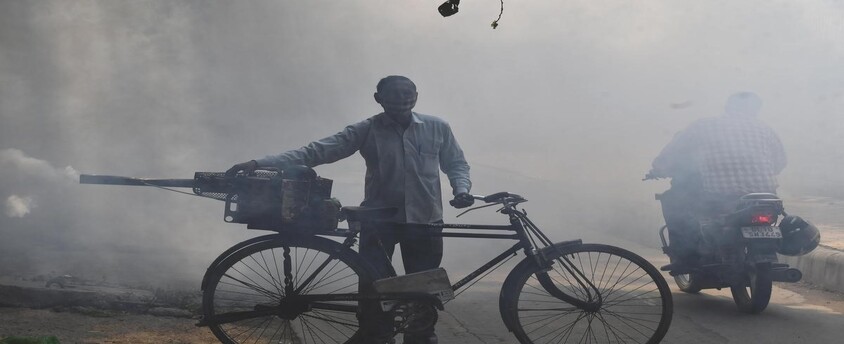Malaria will soon be a notifiable disease across India
25, Apr 2023

Prelims level : Medicine and Pharmaceuticals
Mains level : GS-II Issues relating to development and management of Social Sector or Services relating to Health, Education, Human Resources.
Why in News?
- Malaria is all set to become a notifiable disease across India, with Bihar, Andaman and Nicobar Islands and Meghalaya too in the process of putting this vector-borne disease in the category.
About the News:
- This will then require by law that cases be reported to government authorities.
- Currently malaria is a notifiable disease in 33 States and Union Territories in India.
- Confirming the development, a senior Health Ministry official said this is part of India’s vision to be malaria-free by 2027 and to eliminate the disease by 2030.
- The Health Ministry has also initiated a joint action plan with the Ministry of Tribal Affairs for malaria elimination in tribal areas.
What happens when a disease is put under “Notified” Category?
- The doctors have to report about the occurrence of disease in their patients to the Chief Medical Officer of the district.
- It will help authorities to collect information of the spread of the disease, monitor the disease and set off early warnings.
What is a notified disease?
- Notified diseases are also called Notifiable diseases. It is any disease whose occurrence has to be reported to the Government by law.
WHO on Notifiable Diseases:
- The WHO International Health Regulations, 1969 has made disease reporting mandatory. This will help WHO in its global surveillance and advisory role. Currently the list is limited only to three main disease namely yellow fever, cholera and plague. And of course COVID-19.
OIE on Notified diseases:
- The OIE, World Organisation for Animal Health monitors diseases of animals at global level. It holds a list of notifiable diseases.
Can Central Government declare notified disease?
- As Health is a State subject, only the State Governments have powers to declare notified diseases. However, the Central Government maintains a list of Notified diseases.
List of Notified Diseases in India:
- AIDS, Hepatitis B, Dengue Fever, Malaria, Whooping cough, Anaemia, Measles, Rabies, Vitamin A deficiency, typhoid, scarlet fever, polio, cerebro spinal fever, leprosy, hepatitis, Cholera, Iodine deficiency, malnutrition, tuberculosis, small pox, plague, measles, influenza, diphtheria, chicken pox.
About Malaria:
- Malaria has been one of the world’s deadliest diseases. It kills more than 400,000 people a year worldwide and causes illness in millions of others.
- Africa is home to 70% of the world’s malaria cases and 90% of deaths.
- In the past two decades, existing interventions have reduced the malaria burden. And India, too, has made good progress in malaria control. The disease burden has declined by 59 per cent.
- The success has led to the government in making a commitment to eliminate malaria by 2030.
- Malaria is caused by Plasmodium; the parasites are spread to people through the bites of infected female Anopheles mosquitoes, called “malaria vectors.”
- There are 5 parasite species that cause malaria in humans, and 2 of these species – falciparum and P. vivax – pose the greatest threat.
- In 2018, falciparum accounted for 99.7% of estimated malaria cases in the WHO African Region 50% of cases in the WHO South-East Asia Region, 71% of cases in the Eastern Mediterranean and 65% in the Western Pacific.
- Vivax is the predominant parasite in the WHO Region of the Americas, representing 75% of malaria cases.
What are the Symptoms?
- Malaria is an acute febrile illness. In a non-immune individual, symptoms usually appear 10–15 days after the infective mosquito bite. The first symptoms – fever, headache, and chills – may be mild and difficult to recognize as malaria. If not treated within 24 hours, falciparum malaria can progress to severe illness, often leading to death.
- Children with severe malaria frequently develop one or more of the following symptoms: severe anaemia, respiratory distress in relation to metabolic acidosis, or cerebral malaria. In adults, multi-organ failure is also frequent. In malaria endemic areas, people may develop partial immunity, allowing asymptomatic infections to occur.
What are its Prevention?
- Vector control is the main way to prevent and reduce malaria transmission. If coverage of vector control interventions within a specific area is high enough, then a measure of protection will be conferred across the community.
- WHO recommends protection for all people at risk of malaria with effective malaria vector control. Two forms of vector control – insecticide-treated mosquito nets and indoor residual spraying – are effective in a wide range of circumstances.
What are the India’s efforts to fight Malaria?
- Indian government has released a National Strategic Plan (NSP) for malaria elimination for years 2017-2022, targeting eradication by 2030.
- This marked a shift in focus from malaria “control” to “elimination”. The plan provides a roadmap to achieve the target of ending malaria in 571 districts out of India’s 678 districts by 2022.
- India has sustained significant decline in malaria cases, halving numbers to 5.1 million in 2018 from 9.6 million the year before. This followed a 24% decline in 2017, according to the World Malaria Report 2018.
- Since 2000, India has reduced malaria deaths by two-thirds and halved the number of malaria cases.Scaling up a diagnostic testing, treatment and surveillance
- Ensuring an uninterrupted drug and diagnostics supply chain. Training community workers to test all fever cases and provide medicines, and distributing medicated bed-nets for prevention, under its ‘test-treat-track’ in the endemic north-eastern states and Odisha.






